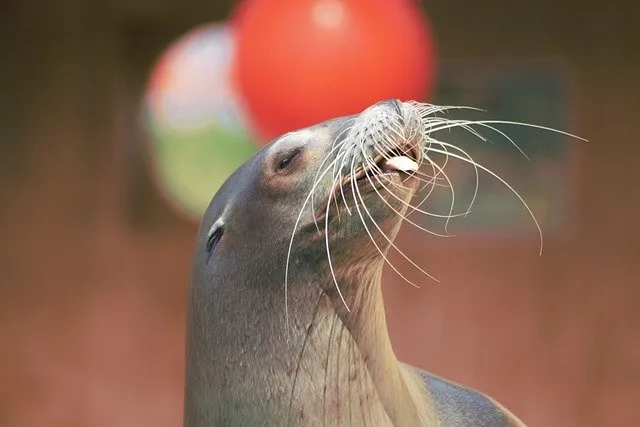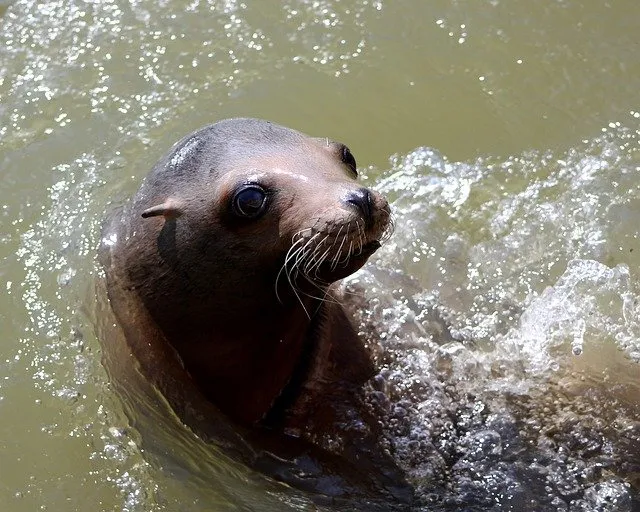As an Amazon Associate I earn from qualifying purchases.
Beneath the vast expanse of the ocean, where sunlight dances through turquoise waves, a world of captivating creatures awaits discovery. Among these magnificent marine inhabitants, sea lions hold a special place, captivating us with their grace, intelligence, and mischievous charm. As we watch them frolic in their aquatic playground, a natural curiosity arises: what do sea lions eat?
In this blog post, we embark on a captivating journey into the gastronomic realm of sea lions, unraveling the enigma of their diet. Prepare to be immersed in a world of flavors and delicacies as we explore the delectable treats that sustain these captivating marine mammals.
What Do Sea Lions Eat?
Regarding marine mammals, sea lions are some of the most captivating creatures. With their playful antics, sleek bodies, and undeniable charm, it’s no wonder they capture the hearts of animal lovers worldwide. However, have you ever wondered what fuels these magnificent beings? In this blog post, we dive deep into the oceanic realm to unravel what sea lions eat. Prepare yourself for a fascinating gastronomic journey through their diet as we explore the delectable treats that sustain these incredible marine creatures.
1.Fish: The Main Course
A feast of fish is at the heart of a sea lion’s diet. With their sharp teeth and agile bodies, these carnivorous creatures are perfectly adapted for hunting and capturing their finned prey. Some fish species they commonly devour include anchovies, herring, salmon, mackerel, and sardines. Fish provide sea lions with a rich source of protein, essential fatty acids, and vital nutrients necessary for survival.
2.Squid: The Slippery Treat
Besides fish, sea lions have a particular affinity for squid. These soft-bodied cephalopods make for an irresistible treat for these pinnipeds. Equipped with suction cups on their tentacles, squid can escape predators. However, sea lions have honed their hunting skills to catch these slippery delicacies. Squid offers sea lions a flavorful and nutritious alternative to fish, adding variety to their diet.
3.Crustaceans: The Crunchy Delights
Sea lions have a diverse palate, which includes a range of crustaceans. These crunchy creatures serve as an important source of sustenance and provide a break from the monotony of a fish-dominated diet. Crabs, shrimp, and lobsters are some of the delectable marine invertebrates that sea lions relish. These crustaceans are packed with valuable proteins and minerals, offering a nutritious boost to the sea lion’s diet.
4.Mollusks: The Shelled Gems
No seafood extravaganza would be complete without mollusks, and sea lions certainly agree. These charismatic marine mammals indulge in various shelled delicacies, such as clams, mussels, and oysters. With their strong jaws and sharp teeth, sea lions are well-equipped to pry open the shells and savor the tasty treasures within. Mollusks provide sea lions with an additional source of proteins, minerals, and essential fatty acids.
5.Tuna: The Oceanic Powerhouse
Tuna deserves a special mention in the sea lion’s diet. Sea lions often pursue these fast and mighty fish due to their abundance and high nutritional value. Tuna, such as yellowfin and skipjack, are rich in omega-3 fatty acids, which are crucial for maintaining the health of sea lions. These oceanic powerhouses provide an energy-packed meal that helps sea lions thrive in their aquatic habitat.
How Do Sea Lions Hunt Their Prey?
Sea lions are skilled hunters that employ various techniques to capture their prey. Their remarkable adaptations and instincts enable them to navigate the oceanic realm in search of a successful hunt. Here are some common hunting strategies employed by sea lions:
Pursuit Hunting:
Sea lions are incredibly agile swimmers, capable of reaching impressive speeds underwater. Sea lions use their speed and agility to chase down their prey when pursuing fast-swimming fish, such as anchovies or salmon. With powerful strokes of their flippers, they swiftly close in on their target, using their streamlined bodies to minimize drag and maximize speed.
Ambush Hunting:
Sea lions often employ an ambush technique when hunting near the shore or rocky areas. They patiently wait, partially submerged or hidden among rocks, and keep a watchful eye on schools of fish passing by. Once an opportune moment arises, they swiftly launch themselves into action, surprising their prey and seizing it in their jaws before it has a chance to escape.
Cooperative Hunting:
In certain situations, sea lions engage in cooperative hunting, especially when targeting larger schools of fish. They encircle the fish by working together, driving them towards shallower waters or a confined area. This coordinated effort increases the chances of a successful catch for each sea lion.
Diving and Foraging:
Sea lions are highly skilled divers, capable of descending to considerable depths in search of prey. They can hold their breath for several minutes and dive to depths of over 300 meters (1,000 feet). While underwater, sea lions use their exceptional vision and sensitive whiskers, known as vibrissae, to locate and track their prey. Once they spot a potential meal, they make swift and precise maneuvers to capture it.
Opportunistic Feeding:
Sea lions are adaptable hunters and opportunistic feeders. They are known to take advantage of various food sources that come their way. For example, they may scavenge on carcasses of marine animals or exploit fishing nets to feed on caught fish. This flexibility allows them to adapt their hunting strategies based on food availability in their environment.
How Can Sea Lions Help Our Ecosystem?
It is crucial to recognize the significant role that sea lions play in ensuring the equilibrium and well-being of marine ecosystems. As top-level predators, they help regulate the populations of their prey species, preventing certain species from becoming overabundant and ensuring a balanced ecosystem. By consuming fish and other marine organisms, sea lions contribute to controlling prey populations, which is vital in preventing ecological imbalances and ensuring the sustainability of marine food webs.
Furthermore, sea lions are essential contributors to nutrient cycling in marine ecosystems. When they consume prey, they absorb vital nutrients from the fish and other organisms they eat. These nutrients are released back into the marine environment through excretion, enriching the surrounding waters. This nutrient-recycling process benefits other organisms in the ecosystem and contributes to the overall productivity and health of the marine environment.
The movement of sea lions also plays a role in the distribution of nutrients within the ocean. These highly mobile animals often travel long distances searching for food and breeding grounds. As they move from one area to another, they transport nutrients, redistributing them across different ocean regions. This movement of nutrients helps to maintain a healthy and diverse marine ecosystem.
Additionally, sea lions serve as indicators of the overall health of their habitat. As they are sensitive to changes in their environment, such as pollution or overfishing, their population status, and behavior can provide valuable insights into the condition of the marine ecosystem. Monitoring sea lion populations and their health can help scientists and conservationists assess the impacts of human activities on the ocean and take necessary measures to protect and restore the ecosystem.
Final Words
In conclusion, sea lions are vital contributors to marine ecosystems, playing a key role in prey regulation, nutrient cycling, and the ocean’s overall health. Understanding and protecting these charismatic creatures is crucial for maintaining the balance and sustainability of our marine habitats.
You can also read:
1.What Do Mantis Eat: A Dive Into Their Eclectic Diet
2.What Do Ermines Eat?: The Culinary Preferences of Ermines
3.Unraveling the Palate of Cooper’s Hawks: What Do Cooper’s Hawks Eat?
4.What Do Coyotes Eat?: A Dive into Their Eclectic Menu!
Amazon and the Amazon logo are trademarks of Amazon.com, Inc, or its affiliates.




